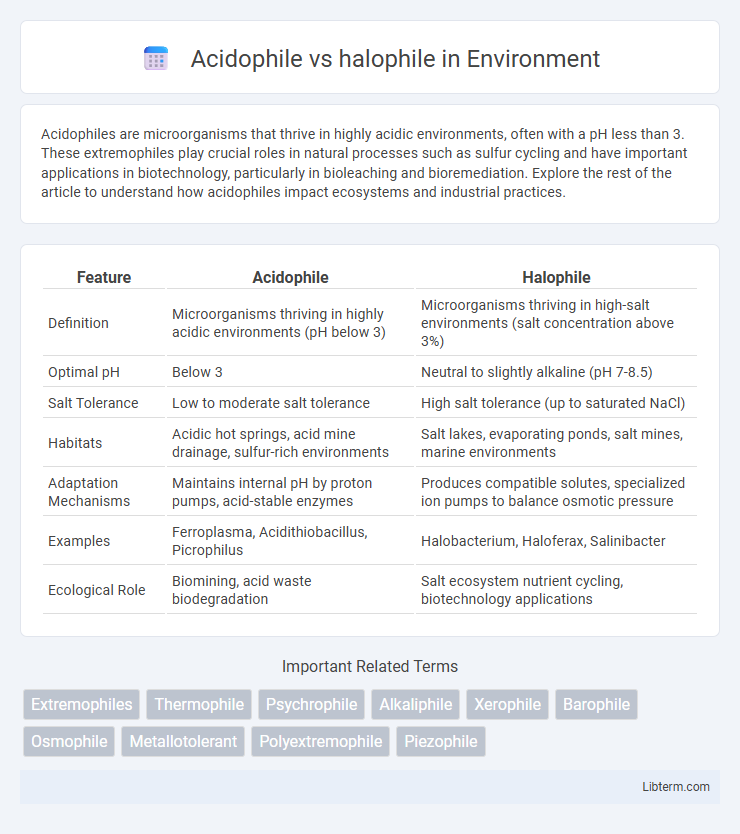Acidophiles are microorganisms that thrive in highly acidic environments, often with a pH less than 3. These extremophiles play crucial roles in natural processes such as sulfur cycling and have important applications in biotechnology, particularly in bioleaching and bioremediation. Explore the rest of the article to understand how acidophiles impact ecosystems and industrial practices.
Table of Comparison
| Feature | Acidophile | Halophile |
|---|---|---|
| Definition | Microorganisms thriving in highly acidic environments (pH below 3) | Microorganisms thriving in high-salt environments (salt concentration above 3%) |
| Optimal pH | Below 3 | Neutral to slightly alkaline (pH 7-8.5) |
| Salt Tolerance | Low to moderate salt tolerance | High salt tolerance (up to saturated NaCl) |
| Habitats | Acidic hot springs, acid mine drainage, sulfur-rich environments | Salt lakes, evaporating ponds, salt mines, marine environments |
| Adaptation Mechanisms | Maintains internal pH by proton pumps, acid-stable enzymes | Produces compatible solutes, specialized ion pumps to balance osmotic pressure |
| Examples | Ferroplasma, Acidithiobacillus, Picrophilus | Halobacterium, Haloferax, Salinibacter |
| Ecological Role | Biomining, acid waste biodegradation | Salt ecosystem nutrient cycling, biotechnology applications |
Introduction to Acidophiles and Halophiles
Acidophiles are microorganisms that thrive in highly acidic environments with a pH typically below 3, while halophiles grow optimally in saline conditions exceeding 0.2 M sodium chloride concentration. These extremophiles possess specialized adaptations such as acid-resistant enzymes and salt-tolerant cellular machinery, enabling survival in habitats like acidic mine drainage or salt flats. Understanding acidophiles and halophiles provides insights into biochemical mechanisms essential for biotechnology and environmental applications.
Defining Acidophiles: Characteristics and Habitats
Acidophiles are extremophilic microorganisms that thrive in highly acidic environments with pH levels typically below 3, often found in sulfur-rich hot springs, acidic mine drainages, and volcanic soils. These organisms exhibit unique adaptations such as acid-stable enzymes and membrane structures that maintain cellular integrity despite low pH conditions. In contrast, halophiles are specialized microorganisms that require high salt concentrations, usually found in environments like salt flats, saline lakes, and salted food products.
Defining Halophiles: Characteristics and Environments
Halophiles are microorganisms that thrive in environments with high salt concentrations, typically above 0.2 M NaCl, exhibiting specialized adaptations such as salt-in strategies and compatible solute accumulation to maintain osmotic balance. These extremophiles inhabit environments like salt lakes, saline soils, and hypersaline ponds, with some archaea species like Halobacterium demonstrating extreme halotolerance. In contrast to acidophiles, which prefer low pH conditions, halophiles optimize their metabolic processes and cellular machinery specifically for survival in hypersaline habitats.
Mechanisms of Acid Tolerance in Acidophiles
Acidophiles maintain cellular integrity in low pH environments through proton efflux pumps that actively expel excess H+ ions, preserving intracellular pH homeostasis. They possess highly impermeable cell membranes with unique lipid compositions to prevent proton influx and produce acid-stable enzymes that function optimally at low pH. DNA repair systems and cytoplasmic buffering molecules further protect acidophiles from acid-induced damage, enabling survival in extreme acidic conditions.
Salt Adaptation Strategies in Halophiles
Halophiles employ specialized salt adaptation strategies such as accumulating compatible solutes like potassium chloride to maintain osmotic balance and stabilize proteins and cellular structures in hypersaline environments. Their intracellular machinery is adapted to function optimally at high salt concentrations, with enzymes that remain stable and active despite extreme ionic conditions. This contrasts with acidophiles, which primarily adapt to low pH rather than high salt, using mechanisms like proton pumps and impermeable membranes to resist acidic stress.
Ecological Roles of Acidophiles vs Halophiles
Acidophiles thrive in extremely acidic environments such as acidic mine drainages and sulfuric hot springs, playing a crucial role in bioleaching by oxidizing sulfide minerals to release metals. Halophiles inhabit hypersaline ecosystems like salt lakes and saline soils, contributing to nutrient cycling by metabolizing organic matter under high-salt conditions. Both microorganisms support specialized ecological niches, with acidophiles driving metal and sulfur biogeochemical cycles while halophiles maintain saline habitat stability through carbon and nitrogen transformations.
Key Differences Between Acidophiles and Halophiles
Acidophiles thrive in extremely acidic environments with pH levels typically below 3, whereas halophiles inhabit high-salinity habitats such as salt lakes and salt flats. Acidophiles possess cellular mechanisms to maintain internal pH homeostasis and prevent acid damage, while halophiles adapt by accumulating compatible solutes or using ion pumps to balance osmotic pressure in hyper-saline conditions. These distinct adaptations reflect the primary environmental stress faced by each group: acidity for acidophiles and salinity for halophiles.
Industrial and Biotechnological Applications
Acidophiles thrive in highly acidic environments and are exploited in bioleaching to extract metals like copper and gold from ores, enhancing mining efficiency. Halophiles, adapted to high-salt conditions, are utilized in the production of salt-tolerant enzymes and bioplastics, supporting sustainable industrial processes under extreme salinity. Both microorganisms contribute to wastewater treatment by degrading pollutants in environments with extreme pH or salinity, expanding biotechnological applications in harsh conditions.
Genetic and Evolutionary Adaptations
Acidophiles possess specialized genes encoding proton pumps and acid-resistant enzymes that maintain intracellular pH stability, enabling survival in extremely acidic environments. Halophiles have evolved unique osmoprotectant synthesis pathways and salt-tolerant proteins, allowing them to thrive in high-salinity habitats by preventing cellular dehydration and protein aggregation. Both organisms exhibit evolutionary adaptations in membrane lipid composition, enhancing structural integrity and function under environmental stressors such as low pH and high salt concentrations.
Future Research Directions in Extremophile Studies
Future research in extremophile studies will increasingly explore the genetic adaptations enabling acidophiles and halophiles to survive in low pH and high-salinity environments, respectively. Advanced metagenomic and proteomic analyses are expected to uncover novel enzymes and metabolic pathways with potential biotechnological applications, including bioleaching and bioremediation. Emphasis on synthetic biology approaches may facilitate the engineering of extremophiles for industrial processes under extreme conditions, enhancing sustainability and efficiency.
Acidophile Infographic

 libterm.com
libterm.com